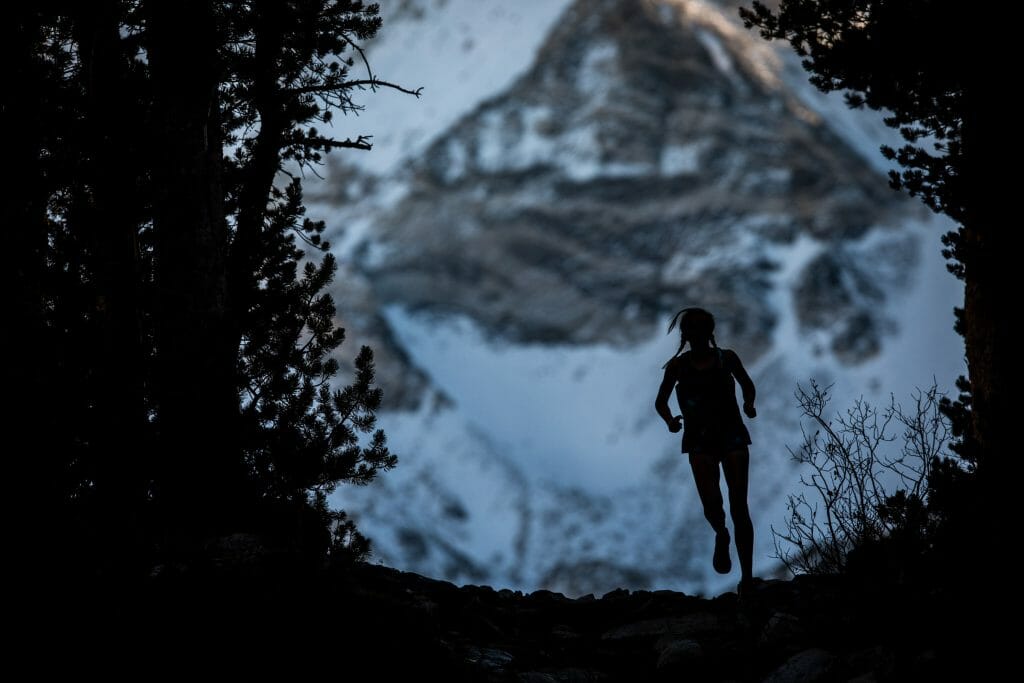Walking uphill as fast as possible at 12,000 feet, my mind racing, no, shuffling, through thoughts of frustration—get it together, Mo, start running. Exhausted and certainly not moving very fast, I swallowed my pride with each gasp of thin mountain air. This isn’t track—this is sky racing. Against my better judgment and instructions from my coach Scott Johnston, I looked down at my watch, which revealed a heart rate number that didn’t lie: 180. Move any faster and I’d quickly turn into roadkill on Kendall Mountain, especially 4 miles into a 12-mile race where my track speed couldn’t save me for shit.
Last spring I was the athlete who survived the 5K and 1500 on a foundation of sprinting and guts rather than any mega base or fitness, but banking on this background for a 12-mile race climbing up to 13,000 feet felt about as awful as you can imagine. My speed allowed me to go out at a fast pace with the lead women without much thought, but this pacing error, relative to my current fitness, caught up with me and cost me dearly.
When I finally got to the 300-vertical-foot goat path to the summit, littered with scree, loose boulders, and steep pitches, I started to have fun again. To smile. Maybe the lack of oxygen got to my head, but once I really started to feel like I was on a mountain a new mentality took over. This is why I made the switch from blazing 12.5 laps around the track to racing in the mountains. I want to be challenged in the most beautiful, treacherous, and ever-changing setting imaginable.
When I turned around and headed down the scree I felt like a new runner again. I bombed down the steep sections and passed what seemed like 15 people before I hit the road again. Really, I did. Once running downhill on the jeep road, I could feel my strength and speed as a runner return; I was flying. For about 3 miles I passed runner after runner and threw myself down the mountain … until my legs gave out. They seized up, wobbled, and refused to turn over at the rate I desperately wanted to will them to move. Never in my life had I had this feeling except at the end of an all-out 400-meter sprint. Now, with 2.5 miles remaining in this race I had to somehow force my legs to keep moving. Visions of sprinting the final mile through town vanished when I reached the flats and found zero response from the same gams that have helped me fly around tracks, bag 14ers, traverse mountain ranges, and out-sprint pro male runners. I had completely wrecked myself.
And then it got worse. I started to bonk. Feeling so dizzy I wasn’t quite sure I could even make it to the finish, I resorted to taking a salted caramel–flavored GU three-quarters of a mile from the finish line. Never had I felt such desperation to prevent a serious bonk. I made it to the finish line without anything left to cap the race with my signature sprint. With hands on quivering knees and still gasping for air, I knew that aside from building a base of aerobic fitness, I have much to learn in the sport of mountain/sky racing, especially with strategy and pacing.
Post-race, Scott and I discussed the race and pinpointed two major errors: going out too fast at the start of the climb and again running too aggressively too early on in the descent. Learning to gauge these efforts, both through trial and error at races and practice during training, will be essential to improved performances and feeling stronger throughout each race. Scott explained to me that these tactical errors can cost me several minutes and finishing places. While I expected to discover a steep learning curve in my transition from track to trail running, I realized from this race that pacing might be one of the biggest changes and most important of all. While fitness and race sharpness will ultimately pay the biggest dividends on race day, even the best preparation can go to waste with poor energy management and race strategy.
As I move into this next phase of training, pure base building, it is my goal to start to pay attention to how I manage my energy and pacing so that it ultimately translates to a successful race when I am truly fit and ready to roll!
-by Morgan Sjogren

